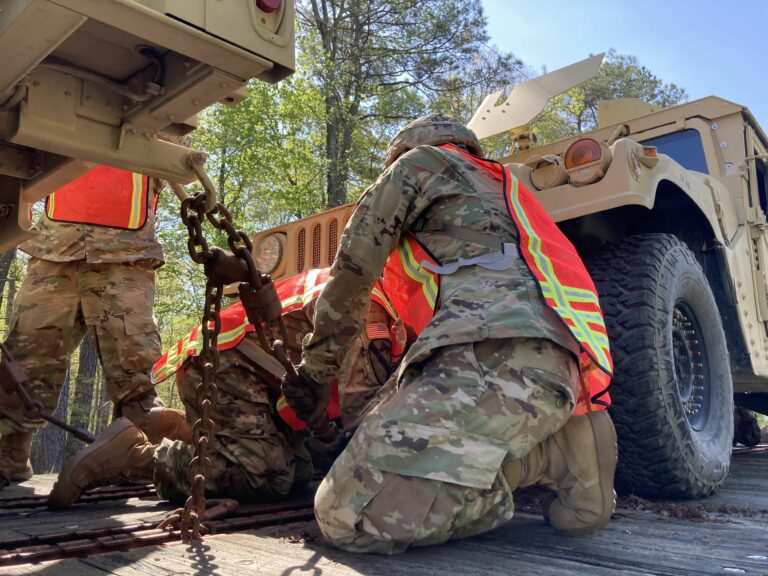
Rumbling up a ramp and onto the railroad flatcar, the Humvee wasn’t quite coming in straight. Spc. Joliyah Turner snapped first her right arm out and then her left to direct it.
Turner was one of more than two dozen soldiers from Fort Eustis’ 757th Expeditionary Rail Center drilling on techniques the Army learned more than a century ago, when it dispatched a couple of officers to follow a traveling circus to see how moved its hundreds of wagons on trains to close in one town and open the next day in another.
“It’s my first time,” she said, after getting the 8,000 pound truck lined up, on a spot just a yard from where she was standing. “It’s a bit nerve-wracking.”
But trailers don’t always track perfectly. The Humvee’s slight turn to its left and then right put the trailer at a slight leftward skew. That would be problem a half-hour later when some of Turner’s fellow soldiers from Fort Eustis’ 678th and 679th Movement Control Teams and Rail Planning and Advisement Teams 4 and 5 had to wrestle thick steel chains with their nine-inch hooks to secure the vehicles.
Figuring out how to cope when loading tanks and trucks on trains that can be up to a mile long, whether the issue is a trailer on a slight skew or a kink in the steel of a flatcar channel that kept a tie down chain’s locking device from working properly, was what the 678th and 679th were practicing.
One option simply wasn’t available. You don’t want to back a 7-foot-wide Humvee and trailer down a 9- or 9 1/2-foot-wide flatcar.
As it happened, the soldiers securing the Humvee and its trailer didn’t get it right the first time they tried, as instructor Antonio Flores, a retired Marine who runs railroading courses at the Marine Corps Logistics Base in Barstow, California, demonstrated with a single, sharp kick.
“Your inspector is going to whack these hard,” he told the soldiers. “He’s not gonna fix it, either. You have to … it’ll hold you up, so one little thing can mean the whole mission isn’t moving.”
The problem, Flores explained, was that the tie-down crew had tried so hard to meet one goal that the missed seeing a basic mistake — tie down chains aren’t supposed to cross one another.
They’re not supposed to cross because the fundamental point about tying down a heavy vehicle on a rail car is to keep the chain parallel to the center lines of both the vehicle and the railcar.
That’s because once a train is moving at 10 mph or more, it starts to rock slowly from side to side. Straight, parallel-to-center line chains basically force those swaying tanks and trucks down onto the railcar. Angled connections could allow those heavy vehicles to move over the side.
It was also why it mattered that Turner and her colleagues practice how to direct drivers down a long line of railcars to exactly the right spot, Flores told them earlier that Sunday morning as he demonstrated the crossed wrists “stop” signal and the, hands emphatically patting down,“slow down” signal.
“You can’t be timid here. … You want them to be driving at idle speed; you don’t want to be hearing grrrr,” he said. “Nobody should be revving ‘em up.”
Moving the Army’s heavy gear means just a question of driving slowly onto a flatcar or muscling heavy steel chains — it’s about knowing how to keep tanks and trucks from falling off a railcar, he said.
Fort Eustis’ railroaders need to be able to plan where each tank, truck, trailer and cargo container will sit on one of those mile-long trains, so that rail cars aren’t overloaded and the right equipment gets off at the right time at the other end.
They learn — and drill — on how to place spanners, the 110-pound, tire-wide bridges that allow military vehicles to drive from one railcar to the next. That was one of the key techniques the Army learned from the circus, back in 1917.
They need to know how to secure heavy equipment — how many tie-down chains, of what size and where best to place them to secure a tank, or a medium tactical vehicle, or a howitzer to a railcar.
Rail cars see hard use, Sgt. James Gallagher said after whaling away with a pipe wrench at a damaged steel lip on one of the flatcar channels that was keeping the locking unit on a tie-down chain for one of the spanners from securing properly.
“Just imagine doing this 60 times,” Gallagher said.
The soldiers practiced throwing railroad switches, and checking to be sure a turnout is set the right way to keep a train from heading down a track where crews are loading or unloading a train.
Working in a rail yard is dangerous, Flores said.
“Part of what we want to teach is being comfortable in this environment, being able to handle it when a tank is coming at you and stops just a few feet away,” he said.
___
(c) 2021 the Daily Press
Distributed by Tribune Content Agency, LLC.
0 comments :
Post a Comment